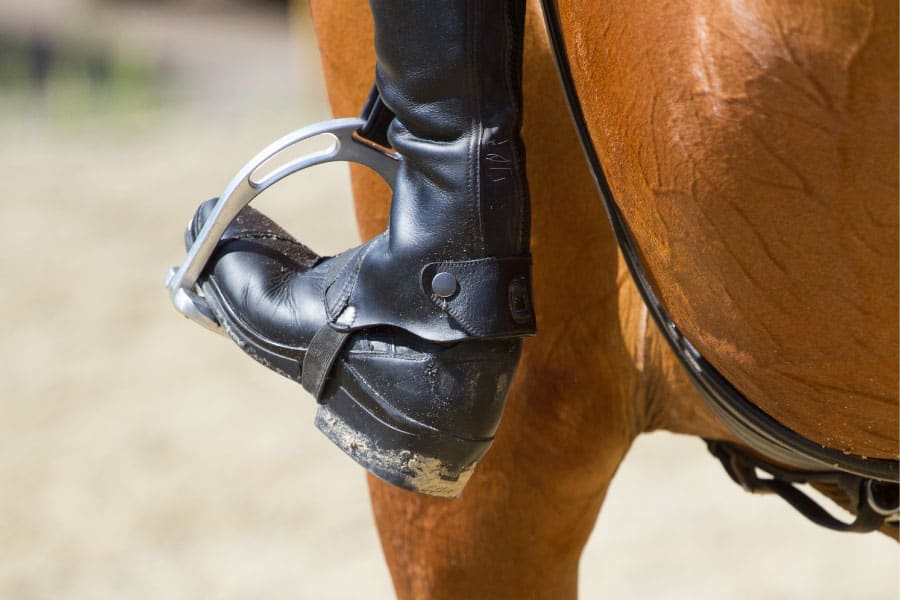- Your source for stall mats, rubber arena footing, arena harrows and arena dust control.

Most horses are no longer used as utility animals; instead, they are partnered with hobbyists, amateur enthusiasts, and dedicated professional athletes, a far cry from the original farm horse or war mount. As the function of the horse has changed, the equestrian dress code has evolved.
Much of equestrianism is based on tradition. Horsemanship methods and techniques have become so entrenched over the centuries that few riders remember to question the status quo.
An equestrian’s dress code is not exempt from the broadscale blind acceptance prevalent in the equestrian community. This begs the question, are traditional equestrian boots still relevant in today’s world of horsemanship, or can a pair of comfortable modern budget-friendly trainers be used?
Trainers are not designed for riding and can become stuck or trapped in the stirrup. A potentially lethal situation occurs if the rider falls and is dragged by their bolting horse. Riding boots are available in many different designs. A rider should invest in their safety by buying riding appropriate boots.
Owning, riding, and training horses is undeniably expensive. Horse owners are always looking for inventive ways to economize. New riders or beginners may not have the budget to buy expensive riding boots and clothes. Most trainers are designed for sports, and many people try to reason that because horse riding is a sport, an athletic shoe will work.
The trainers are comfortable, affordable, and easy to wear. On the surface, wearing trainers for riding would seem to be a logical choice. Using trainers might save your budget, but have you inadvertently sacrificed your safety in the name of economizing?
History of Trainers
The first trainers were developed in the early 1800s in Britain. They were constructed of a soft canvas upper glued to a vulcanized rubber sole for use on the beach. The shoes quickly gained popularity, and over the centuries, their appearance may have been altered, but their popularity has never diminished.
Standard trainers typically have no heel, a rubber sole with deep treads, and a broad toe box. In essence, trainers are the antithesis of a correct riding boot and one of the most dangerous shoes to wear while riding.
Safety First
It is an undisputed fact that horses can be dangerous. Horses are large animals that move fast and react even faster. The best of riders will still experience multiple falls and injuries throughout their riding career. Accidents happen to even the most cautious of horse riders! Over 80% of all riders will experience a horse-related injury, although the severity may differ from mild to lethal.
The advent of the 20th and 21st centuries saw an increased emphasis being placed on safety to ensure both the horse and rider’s long-term well-being and health. When new riders ask me what equipment they need to ride safely, I will always advise that they buy the best riding helmet and boots they can afford.
The riding helmet is probably the most vital piece of rider wear, with riding boots falling in a close second.
Injuries associated with Incorrect Footwear
Falling off and being dragged has potentially lethal consequences for the rider. Most riders are dragged because their foot becomes stuck in the stirrup, and they cannot pull it loose. These riders are left flailing next to the horse, powerless to protect their head, shoulders, and torso from the hooves pounding inches from their face.
A small percentage of exceptional horses may be able to act against their instincts and stop when their rider falls and becomes stuck, allowing the rider to free themselves. Most horses do not belong to that small exemplary group of horses; rather, they will become frightened by the rider dangling next to them. A frightened horse will try to run away from the “scary” person and will bolt, dragging the rider with them.
The rider may suffer extensive musculoskeletal damage to the stuck leg, foot, and ankle. There may be profound internal injuries to the organs and brain as the rider is kicked and stood on by the galloping horse. Friction burns, bruising, and contusions are most extensive on the rider’s back and side from being dragged along the ground, especially if the surface is a tar or dirt road. It is rare for a rider to be unharmed after being dragged.
Many lethal riding accidents occur because the rider was dragged and unable to free himself in time. There is an unacceptably high risk of a trainer-wearing rider’s foot becoming stuck in the stirrup.

Choosing the Correct Riding Footwear
Regardless of which boot you choose; the boots should be designed to have:
- 2 cm to 3 cm tall heel
- A smooth sole or sole with a minimal tread pattern
- Have a narrow foot component
- Be made of smooth material that will not catch or become “stuck” on the stirrup.
- Support the ankle and leg
Boots should allow you to move and function optimally. Incorrect shoes can result in knee, hip, or back pain.
The riding discipline you choose to ride in will have a strong influence on the type of shoes and boots you choose to wear. Many English riders choose to wear leather long- boots. Long- boots encase the foot and extend up to the knee.
These boots are typically fastened with a zip positioned at the back of the leg. Long- boots may be very stiff when they are first brought and require a breaking in period that can be extremely uncomfortable for the wearer. Once broken in, these boots will soften and mold to the rider’s leg and foot.
The traditional long- boot is quite restrictive and has a mild immobilizing effect on the ankle. In the event of a leg fracture, the calf portion of the boot will function as a temporary immobilizing brace as the rider is transported to the hospital. The zip extending down the length of the calf boot will allow the boot to be removed with minimal ankle movement.
- Jodhpur boots are not as restrictive to ride and walk in as long boots. Many riders choose to pair their jodhpur boots with half chaps or gaiters for additional leg protection and a more traditional look. Jodhpur boots are cheaper than long boots.
- Cowboy boots were originally designed to facilitate a cowboy’s work on the ranch. These boots are stylish, safe, and designed for hard work. When choosing a cowboy boot, look for a more traditional design with no protruding embellishments that may become tangled with the stirrup and saddle.
- Multi-purpose hiking-riding boots. Equestrian footwear manufacturers have designed multi-purpose hiking-riding boots. These boots tend to be narrower and have a less pronounced tread than traditional hiking boots. Many extreme trail riders and endurance riders favor these boots. They are safe to ride in and function as comfortable boots to hike in when the rider needs to give the horse a break or navigate a difficult section of the trail on foot.
Stirrups
When choosing stirrups, make sure there is at least a 1 cm to 2 cm gap on either side of your booted foot when standing in the stirrups.
Stirrups can be designed with breakaway components such as an elastic rubber on the outside of the stirrup. When the rider falls, the rubber component snaps and allows the rider’s foot to fall free of the stirrup.
Some western and endurance stirrups are fitted with hoods or cages around the front of the stirrup to prevent your foot from sliding forward and getting stuck in the stirrup.
Feel free to check out our comprehensive guide on how to choose the right stirrups here .
.
Conclusion
Riding boots versus sneakers is not a question of fashion, convenience, or finances but rather one of safety. A rider cannot safely ride in sneakers. The potential for a serious riding accident is significant. The only safe boot to ride in is one that meets the criteria outlined in this article. The boot used by the rider should ideally be purpose-made for riding.

